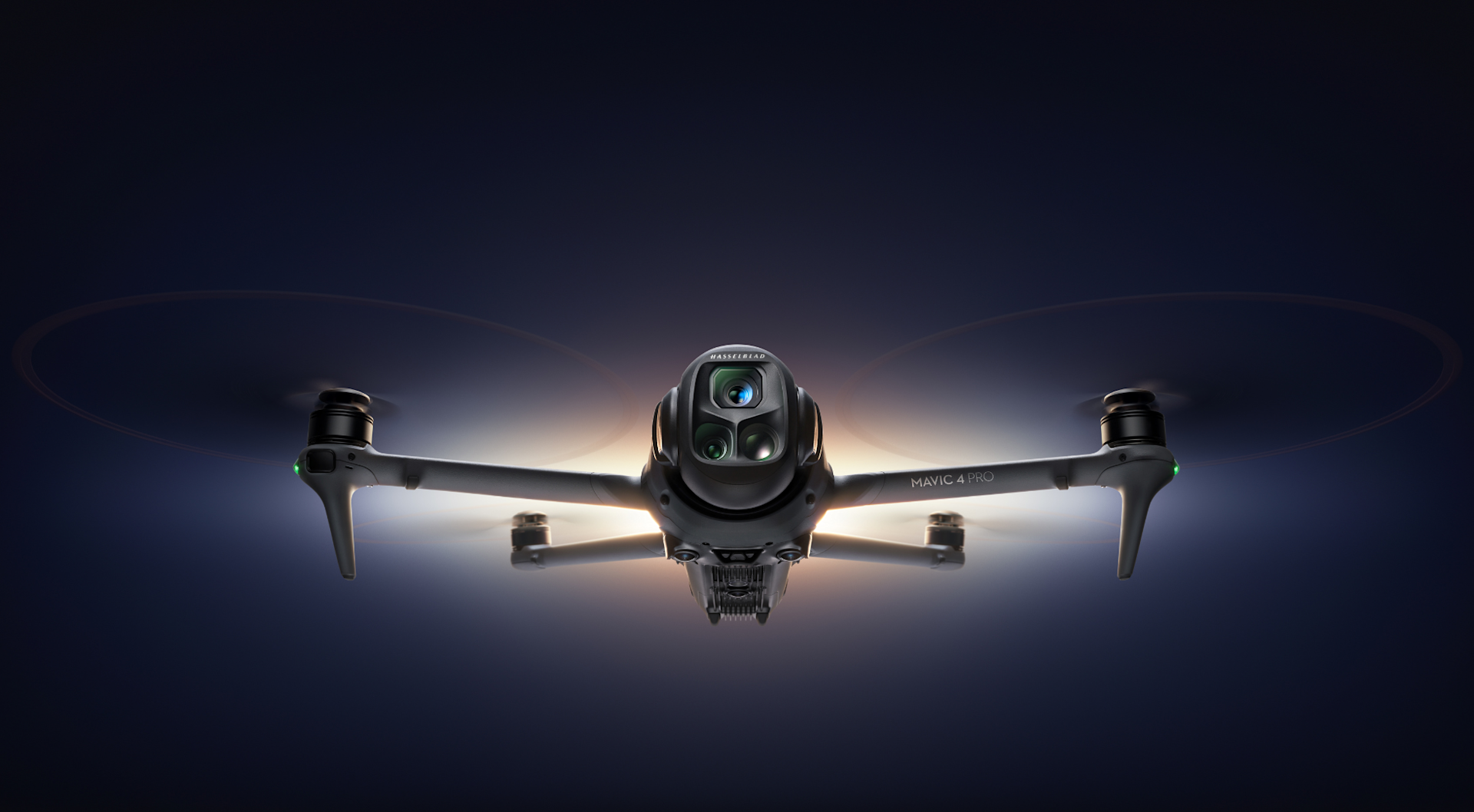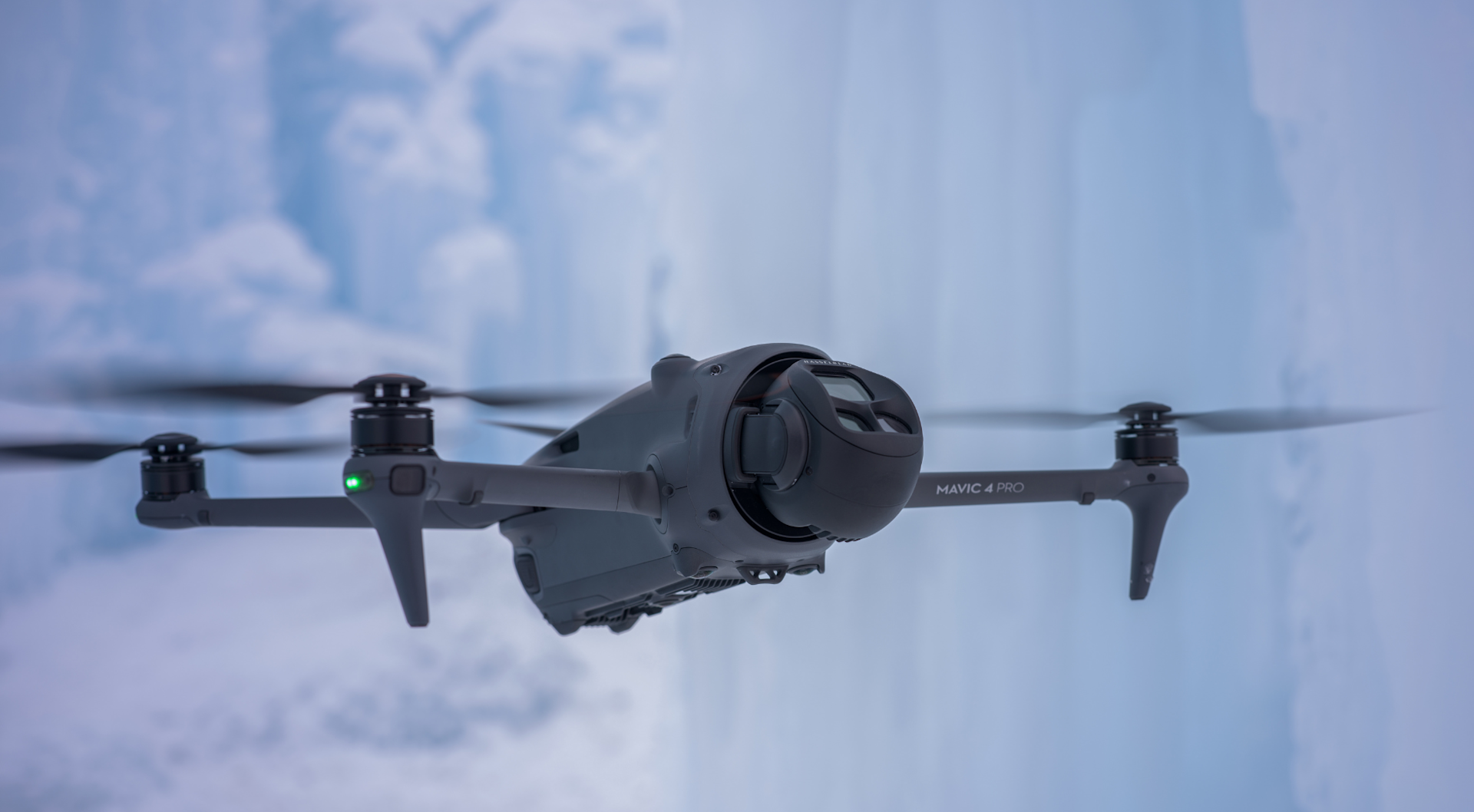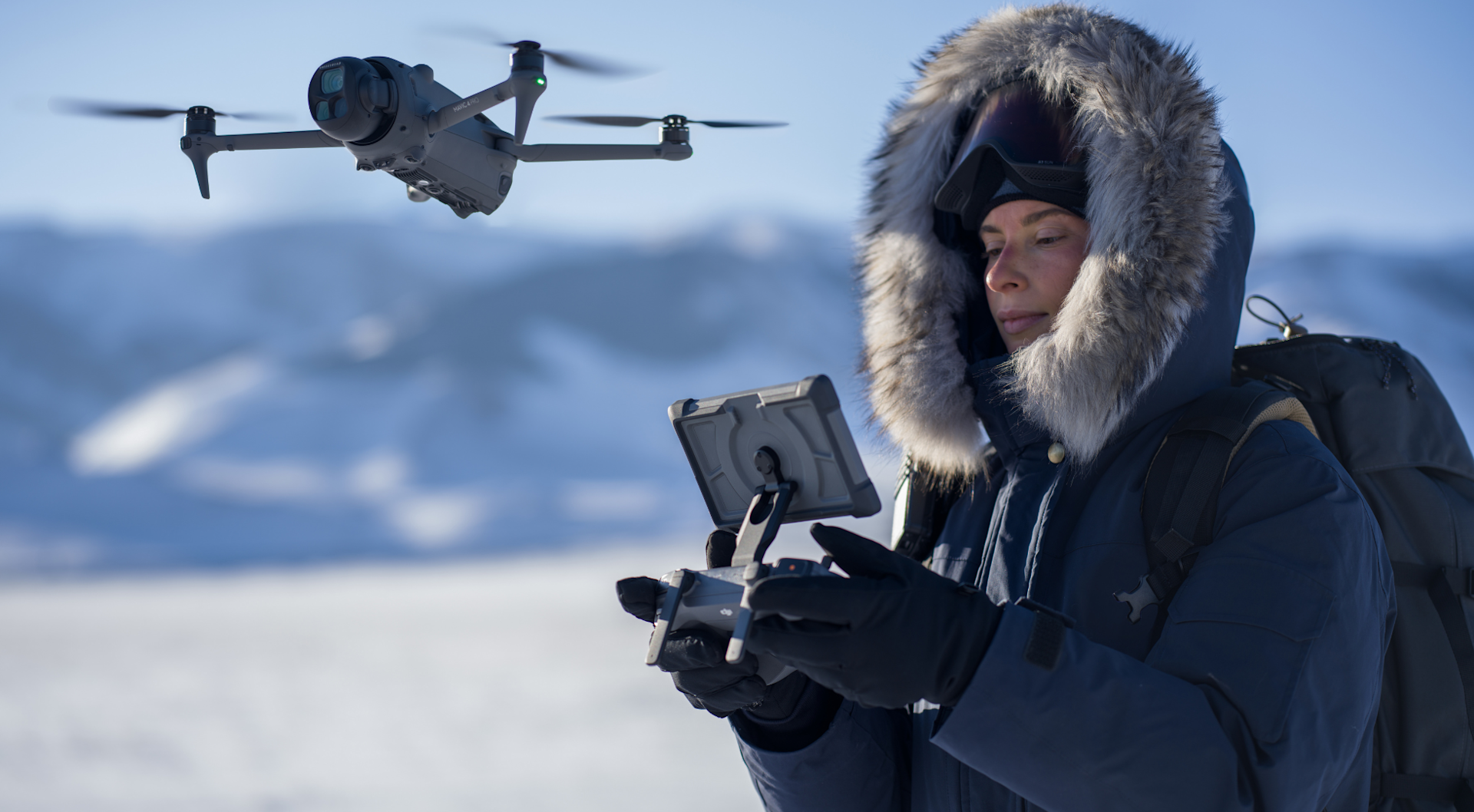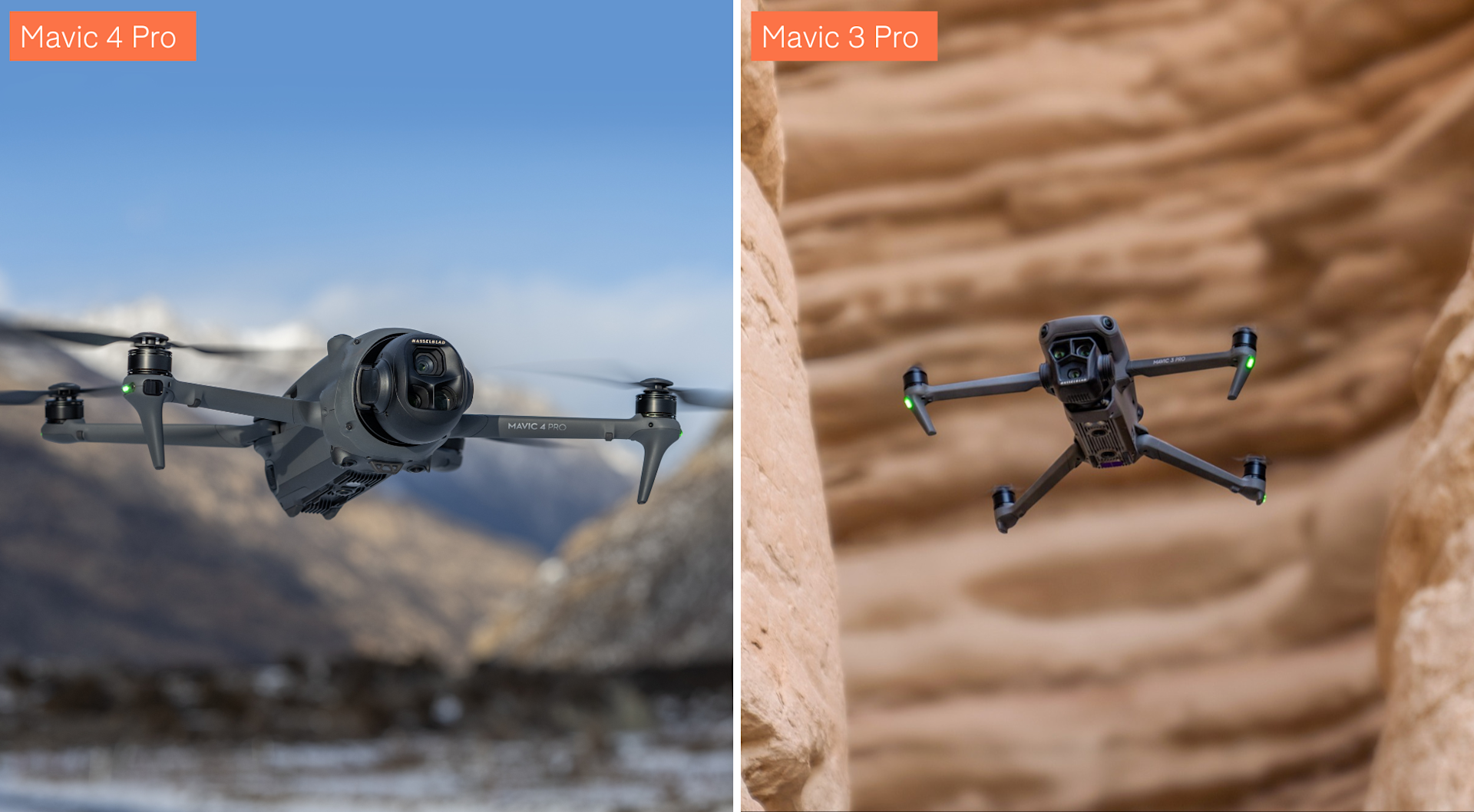
Products
Published on 13 May 2025
Jamie Collier
DJI Mavic 4 Pro Vs DJI Mavic 3 Pro
A side-by-side comparison—breaking down cameras, flight time, smart features, and controller options.
We look at...
Camera System Comparison: Explore the differences between the Mavic 4 Pro and Mavic 3 Pro triple-camera setups, including sensor size, resolution, and advanced imaging features.
Video Performance: Understand how frame rates, recording formats, and colour profiles differ for professional-grade video production.
Flight Capabilities: Compare flight time, range, transmission systems, and obstacle avoidance technologies.
Gimbal and Shooting Flexibility: Learn about the Infinity Gimbal on the Mavic 4 Pro and how it changes the way you shoot.
Remote Controller Options: Review compatibility and features of DJI’s latest RCs, including the RC Pro 2.
The DJI Mavic 4 Pro is the latest evolution of DJI’s Mavic Pro Series, building on the strengths of the Mavic 3 Pro with significant improvements in camera technology, gimbal design, and smart features.
But how much of a leap is it really, and is it worth upgrading?

This blog compares the Mavic 4 Pro and Mavic 3 Pro across the most important categories: camera systems, video performance, gimbals, flight time, obstacle sensing, and controller compatibility.
Key specs at a glance
Feature | DJI Mavic 4 Pro | DJI Mavic 3 Pro |
|---|---|---|
Weight | 1063 g | 958 g |
Dimensions (Folded) | 257.6 x 124.8 x 106.6 mm (with props) 257.6 x 124.8 x 103.4 mm (without props) | 231.1 x 98 x 95.4 mm |
Dimensions (Unfolded) | 328.7 × 390.5 × 135.2 mm | 347.5 × 290.8 × 107.7 mm |
Image Sensor | Hasselblad: 4/3 CMOS, 100 MP Medium Tele: 1/1.3", 48 MP Tele: 1/1.5", 50 MP | Hasselblad: 4/3 CMOS, 20 MP Medium Tele: 1/1.3", 48 MP Tele: 1/2", 12 MP |
Max Video Resolution | Hasselblad: 6K/60fps HDR or 4K/120fps Medium Tele: 4K/60fps HDR or 4K/120fps Tele: 4K/60fps HDR or 4K/100fps | 5.1K/50fps |
Gimbal | Infinity Gimbal with 360° Rotation 70° Upward Shooting Supported True Vertical Shooting Not Supported | 35° Upward Shooting Supported |
Focusing and Tracking | Subject Focusing FocusTrack: ActiveTrack 360°, Spotlight, POI | Subject Focusing Not Supported FocusTrack: ActiveTrack, Spotlight, POI |
Obstacle Sensing | 0.1 Lux Nightscape Omnidirectional (All directions) Equipped with Forward-Facing LiDAR | Omnidirectional Obstacle Sensing (All directions) |
Max Flight Time | 51 mins | 43 mins |
Max Transmission | 30 km (FCC) 15 km (CE/SRRC/MIC) | 15 km (FCC) 8 km (CE/SRRC/MIC) |
Camera system
A closer look the Mavic 4 Pro & Mavic 3 Pro cameras...
Feature | Mavic 4 Pro | Mavic 3 Pro |
|---|---|---|
Main Camera Sensor | 4/3 CMOS, 100 MP (Hasselblad) | 4/3 CMOS, 20 MP (Hasselblad) |
Medium Tele Sensor | 1/1.3" CMOS, 48 MP | 1/1.3" CMOS, 48 MP |
Tele Sensor | 1/1.5" CMOS, 50 MP | 1/2" CMOS, 12 MP |
Main Camera Lens | 28 mm eq., f/2.0–f/11, FOV: 72° | 24 mm eq., f/2.8–f/11, FOV: 84° |
Medium Tele Lens | 70 mm eq., f/2.8, FOV: 35° | 70 mm eq., f/2.8, FOV: 35° |
Tele Lens | 168 mm eq., f/2.8, FOV: 15° | 166 mm eq., f/3.4, FOV: 15° |
ISO (Video) | Main: 100–12800 Medium/Tele: 100–12800 | Normal: 100–6400 Night: 800–12800 |
Shutter Speed (Main) | 1/16000–16 s (25 MP) 1/8000–8 s (100 MP) | 8–1/8000 s |
Max Image Size | Main: 12288×8192 Medium: 8064×6048 Tele: 8192×6144 | Main: 5280×3956 Medium: 8064×6048 Tele: 4000×3000 |
Still Modes | 25 MP / 100 MP Single Shot, AEB, Burst, Timed | 20 MP Single, AEB, Burst, Timed |
Photo Format | JPEG, DNG (RAW) | JPEG, DNG (RAW) |
Video Resolution (Main) | Up to 6K@60fps, 4K@120fps | 5.1K@50fps, 4K@120fps, FHD@200fps |
Video Format | MP4 (H.264/H.265/ALL-I*) *Only Mavic 4 Pro 512GB (Creator Combo) supports H.264 ALL-I recording | MP4/MOV (H.264/H.265), MOV (Apple ProRes 422 HQ/422/422 LT) *Only Mavic 3 Pro Cine supports MOV (Apple ProRes) |
Max Video Bitrate | H.264: 90 Mbps, H.265: 180 Mbps, ALL-I: 1200 Mbps* *Only Mavic 4 Pro 512GB (Creator Combo) supports H.264 ALL-I recording | Hasselblad Camera: H.264/H.265: 200 Mbps ProRes 422 HQ: 3772 Mbps ProRes 422: 2514 Mbps ProRes 422 LT: 1750 Mbps Medium Tele Camera: H.264/H.265: 160 Mbps ProRes 422 HQ: 1768 Mbps ProRes 422: 1178 Mbps ProRes 422 LT: 821 Mbps Tele Camera: H.264/H.265: 160 Mbps ProRes 422 HQ: 1768 Mbps ProRes 422: 1178 Mbps ProRes 422 LT: 821 Mbps *Only Mavic 3 Pro Cine version supports ProRes recording. |
Colour & Sampling | Hasselblad Camera Normal Colour: 10-bit 4:2:2 (H.264 ALL-I) 10-bit 4:2:0 (H.265 Standard) 8-bit 4:2:0 (H.264 Standard) HLG/D-Log M/D-Log: 10-bit 4:2:2 (H.264 ALL-I) 10-bit 4:2:0 (H.265 Standard) Medium Tele Camera Normal Color: 10-bit 4:2:2 (H.264 ALL-I) 10-bit 4:2:0 (H.265 Standard) 8-bit 4:2:0 (H.264 Standard) HLG/D-Log M/D-Log: 10-bit 4:2:2 (H.264 ALL-I) 10-bit 4:2:0 (H.265 Standard) Tele Camera Normal Color: 10-bit 4:2:2 (H.264 ALL-I) 10-bit 4:2:0 (H.265 Standard) 8-bit 4:2:0 (H.264 Standard) HLG/D-Log M/D-Log: 10-bit 4:2:2 (H.264 ALL-I) 10-bit 4:2:0 (H.265 Standard) *Only Mavic 4 Pro 512GB (Creator Combo) supports H.264 ALL-I recording. | Hasselblad Camera Normal: 10-bit 4:2:2 (Apple ProRes 422 HQ/422/422 LT) 8-bit 4:2:0 (H.264/H.265) D-Log: 10-bit 4:2:2 (Apple ProRes 422 HQ/422/422 LT) 10-bit 4:2:0 (H.264/H.265) HLG/D-Log M: 10-bit 4:2:2 (Apple ProRes 422 HQ/422/422 LT) 10-bit 4:2:0 (H.265) Medium Tele Camera Normal: 10-bit 4:2:2 (Apple ProRes 422 HQ/422/422 LT) 8-bit 4:2:0 (H.264/H.265) HLG/D-Log M: 10-bit 4:2:2 (Apple ProRes 422 HQ/422/422 LT) 10-bit 4:2:0 (H.265) Tele Camera Normal: 10-bit 4:2:2 (Apple ProRes 422 HQ/422/422 LT) 8-bit 4:2:0 (H.264/H.265) HLG/D-Log M: 10-bit 4:2:2 (Apple ProRes 422 HQ/422/422 LT) 10-bit 4:2:0 (H.265) *Only Mavic 3 Pro Cine version supports ProRes recording. |
Supported Colour Profiles | Normal, D-Log, D-Log M, HLG | Normal, D-Log, D-Log M, HLG |
Digital Zoom | Main: 1x–2.5x Medium: 2.5x–6x Tele: 6x–24x | Main: 1x–3x Medium: 3x–7x Tele: 7x–28x |
File System | exFAT | exFAT |
How the Mavic 4 Pro and Mavic 3 Pro triple-camera systems compare
Both aircraft have triple camera setups, but very different capabilities. The Mavic 4 Pro takes shooting high-quality content to the next level.

DJI Mavic 4 Pro
Main Hasselblad Camera The Mavic 4 Pro features a 4/3 CMOS Hasselblad sensor with an outstanding 100MP resolution—five times the resolution of the 20MP sensor in the Mavic 3 Pro.
This upgrade allows for much greater image detail and post-production flexibility. The Mavic 4 Pro also supports 6K/60fps HDR video, compared to the Mavic 3 Pro’s 5.1K/50fps.
Both models offer an adjustable aperture from f/2.0 to f/11 and support 10-bit D-Log and HLG colour profiles, but the Mavic 4 Pro introduces RAW image stacking and enhanced colour reproduction through the Hasselblad Natural Colour Solution.
Medium telephoto camera Both drones are equipped with a 70mm medium telephoto lens using a 1/1.3-inch CMOS sensor.
However, the Mavic 4 Pro pairs this with a newer image processing engine, delivering sharper results and improved dynamic range.
It also supports 4K/120fps recording, while the Mavic 3 Pro tops out at 4K/60fps.
Telephoto camera The Mavic 4 Pro upgrades its long telephoto camera to a 50MP 1/1.5-inch sensor, a significant step up from the 12MP 1/2-inch sensor on the Mavic 3 Pro. This results in much sharper detail when zoomed in. Both drones offer high levels of optical and hybrid zoom, but the Mavic 4 Pro benefits from enhanced clarity and Subject Focusing to maintain tracking on distant objects.
Imaging features The Mavic 4 Pro introduces Dual Native ISO Fusion across all lenses, significantly improving low-light performance and expanding dynamic range.
Features like Free Panoramas and Subject Focusing give users greater creative control, while all three cameras support consistent colour grading and exposure handling—essential for professional editing workflows.
Mavic 4 Pro Creator Combo vs Mavic 3 Pro Cine
Mavic 4 Pro and Mavic 3 Pro are designed for high-end content creation.
But when it comes to tools for professional movie-makers and filmhouses, the Mavic 3 Pro has the Cine, while the Mavic 4 Pro has the 512GB version that comes in the Creator Combo.
The Mavic 4 Pro in the Creator Combo comes with 10-bit 4:2:2 video recording through All-I encoding. This capability captures richer colour details, offering a superior editing experience. In comparison, the Cine comes with Apple ProRes capabilities.
ALL-i encoding is a common format in mirrorless cameras, utilising intra-frame compression similar to ProRes. Less compression results in a larger file size compared to inter-frame encoding, but it also provides a better editing experience in post-processing.
The Mavic 4 Pro features a built-in 512GB high-capacity SSD, while the Cine is equipped with 1TB of on-board storage.
Gimbal and tracking
The Mavic 4 Pro introduces the Infinity Gimbal, expanding camera movement, and its tracking features have been significantly improved—allowing operators to follow subjects even when only partially in view.
Let's take a better look at the gimbal mechanics.
Feature | Mavic 4 Pro | Mavic 3 Pro |
|---|---|---|
Stabilisation | 3-axis mechanical gimbal (tilt, roll, pan) | 3-axis mechanical gimbal (tilt, roll, pan) |
Mechanical Range | Tilt: -164° to 160° Roll: -90° to 450° Pan: -22° to 22° | Tilt: -140° to 50° Roll: -50° to 50° Pan: -23° to 23° |
Controllable Range | Tilt: -90° to 70° Roll: -40° to 400° | Tilt: -90° to 35° Pan: -5° to 5° |
Max Control Speed | Tilt: 100°/s Roll: 100°/s | Tilt: 100°/s |
Angular Vibration Range | ±0.001° (hovering without wind)±0.003° (normal mode)±0.005° (sport mode) | ±0.001° (hovering without wind)±0.003° (normal mode)±0.005° (sport mode) |
Gimbal design and rotation The Mavic 4 Pro introduces DJI’s new Infinity Gimbal, offering 360° rotation for unmatched camera movement. This allows operators to achieve Dutch angles, upward-facing shots, and fluid transitions that are simply not possible on previous Mavic models.
It supports 70° upward tilt, ideal for capturing architectural structures and elevated subjects from dynamic angles.

DJI Mavic 4 Pro upward shot
By comparison, the Mavic 3 Pro uses a standard three-axis gimbal with a 35° upward tilt. While stable and smooth, it lacks the creative flexibility offered by the Mavic 4 Pro's full rotation design.
Intelligent tracking The Mavic 4 Pro also improves upon DJI’s ActiveTrack system with ActiveTrack 360°. This feature delivers reliable subject tracking even in low-light conditions, such as twilight or urban environments.
It maintains focus even when the subject is partially obscured or in complex surroundings. The enhanced subject recognition can track people or vehicles with directional awareness, particularly useful for automotive filming.
The Mavic 3 Pro includes FocusTrack, which features ActiveTrack, Spotlight, and Point of Interest modes.
While these modes offer solid tracking performance, the Mavic 4 Pro’s updated system brings smoother transitions, better low-light accuracy, and more versatile object following during dynamic flight.
Subject focusing Exclusive to the Mavic 4 Pro, Subject Focusing enhances precision by locking onto the chosen subject across all three cameras.
This ensures that even when changing focal lengths or zooming, the drone maintains sharp focus on the intended point of interest—ideal for professional cinematography or inspections requiring consistent detail.
Flight performance and safety features
The Mavic 4 Pro is faster and more responsive than the Mavic 3 Pro, with longer flight time, more advanced obstacle sensing, and an improved Smart Return to Home that uses LiDAR for greater accuracy.
Flight time and range The Mavic 4 Pro offers a significant increase in flight performance, with a maximum flight time of up to 51 minutes. This is 8 minutes longer than the Mavic 3 Pro’s 43-minute flight time, giving pilots more opportunity to capture content without interruption.
In terms of range, the Mavic 4 Pro uses the latest DJI O4+ transmission system, enabling a transmission distance of up to 30km (FCC) or 15km (CE), compared to the Mavic 3 Pro’s 15km (FCC) and 8km (CE) range using the older O3+ system.
Feature | Mavic 4 Pro | Mavic 3 Pro |
|---|---|---|
Max Ascent Speed | 10 m/s (Sport)6 m/s (Normal/Cine) | 8 m/s |
Max Descent Speed | 10 m/s (Sport)6 m/s (Normal/Cine) | 6 m/s |
Max Horizontal Speed | 25–27 m/s (Sport)15 m/s (Tracking) | 21 m/s |
Max Takeoff Altitude | 6000 m (3000 m with prop guards) | 6000 m |
Max Flight Time | 51 minutes | 43 minutes |
Max Hovering Time | 45 minutes | 37 minutes |
Max Flight Distance | 41 km | 28 km |
Max Wind Resistance | 12 m/s | 12 m/s |
Max Tilt/Pitch Angle | 35° | 35° |
Operating Temperature | -10°C to 40°C | -10°C to 40°C |
Global Navigation Satellite System | GPS + Galileo + BeiDou | GPS + Galileo + BeiDou |
Hovering Accuracy | Vertical: ±0.1 m (vision), ±0.5 m (GNSS)Horizontal: ±0.3 m (vision), ±0.5 m (GNSS) | Vertical: ±0.1 m (vision), ±0.5 m (GNSS)Horizontal: ±0.3 m (vision), ±0.5 m (GNSS) |
Internal Storage | 64 GB / 512 GB (approx. 42–460 GB usable) | 8 GB (approx. 7.9 GB usable) |
EU Drone Class | C2 | Not specified |
Navigation and obstacle-sensing A major improvement comes in the form of 0.1-Lux Nightscape Omnidirectional Obstacle Sensing on the Mavic 4 Pro.
This upgraded sensing system includes six fisheye vision sensors with low-light sensitivity and forward-facing LiDAR, allowing the drone to detect and avoid obstacles even in near-darkness.
It also supports Non-GPS RTH by memorising flight paths using real-time vision positioning—useful for launching from balconies or shaded areas.
The Mavic 3 Pro includes standard omnidirectional obstacle sensing and performs well in most conditions, but it lacks the low-light capabilities and LiDAR support offered by the Mavic 4 Pro.
This makes the newer model more suitable for challenging environments or night operations.
Feature | Mavic 4 Pro | Mavic 3 Pro |
|---|---|---|
Sensing System | Omnidirectional binocular vision + forward LiDAR + downward IR | Omnidirectional binocular vision + bottom IR sensor |
Forward Sensing | 0.5–24 m (Meas.)0.5–200 m (Detect)≤18 m/sFOV: 180°×180° | 0.5–20 m (Meas.)≤15 m/sFOV: 90°×103° |
Backward Sensing | 0.5–22 m (Meas.)0.5–200 m (Detect)≤18 m/sFOV: 180°×180° | 0.5–16 m (Meas.)≤12 m/sFOV: 90°×103° |
Lateral Sensing | 0.5–21 m (Meas.)0.5–200 m (Detect)≤18 m/sFOV: 180°×180° | 0.5–25 m (Meas.)≤15 m/sFOV: 90°×85° |
Upward Sensing | 0.5–18 m≤6 m/sFOV: 90°×90° | 0.2–10 m≤6 m/sFOV: 100° (FB) × 90° (LR) |
Downward Sensing | 0.5–17 m≤6 m/sFOV: 180°×180° | 0.3–18 m≤6 m/sFOV: 130° (FB) × 160° (LR) |
Additional Sensors | Forward LiDAR: 0.5–25 m (night), FOV: 60°×60° Downward IR: 0.3–8 m, FOV: 60°×60° | Bottom infrared sensor only |
Operating Environment | Vision sensors: patterned surfaces + lux > 0.1IR: reflectivity > 20% | Vision sensors: patterned surfaces + lux > 15IR: reflectivity > 20% |
Smart Return-to-Home Both drones support Smart RTH, but the Mavic 4 Pro goes further by using LiDAR and vision positioning to avoid buildings and other vertical obstacles during automatic return.
Its Nighttime RTH mode ensures safe returns even in dim conditions, making it a more capable choice for evening flights or unpredictable lighting environments.
Controller compatibility
The DJI Mavic 4 Pro is compatible with two controllers: the DJI RC 2 and the DJI RC Pro 2.
The standard RC 2 offers solid functionality with a bright screen and intuitive controls, but the RC Pro 2 unlocks the full potential of the drone.

DJI Mavic 4 Pro with DJI RC Pro 2
Featuring a 7-inch high-bright Mini-LED display, the RC Pro 2 is designed for professional users. The rotatable screen syncs with the gimbal to support vertical shooting, and the controller powers on automatically when extended.
It also includes a built-in mic and native support for DJI Mic systems, streamlining content creation on the go.
In comparison, the Mavic 3 Pro comes standard with the DJI RC. It’s a lightweight and capable controller with a 5.5-inch 700-nit screen, ideal for general use.

DJI RC
The Mavic 3 Pro Fly More Combo offers an upgrade to the DJI RC Pro, which adds a brighter screen and faster processing.
However, the Mavic 4 Pro’s RC Pro 2 is clearly the more advanced option, especially for high-end filmmaking and multi-cam workflows.
Ecosystem features
Both drones support DJI FlightHub 2 and DJI Terra, but the Mavic 4 Pro benefits from the improved O4+ transmission system, which offers greater signal stability and lower latency—particularly valuable when working in built-up areas or with multiple drones on set.
The RC Pro 2 also features a flight simulator, which helps new users practise in a safe virtual environment. This is an ideal onboarding tool for new pilots or businesses training staff.
The Mavic 4 Pro is compatible with DJI’s latest charging and storage solutions, including a parallel charging hub that fully charges three batteries in just 90 minutes. The Creator Combo includes a drone with a built-in 512GB SSD, making it easier to handle large video files directly from the field.
Key takeaways
The DJI Mavic 4 Pro builds on the strong foundation of the Mavic 3 Pro and introduces meaningful improvements in nearly every area. Its 100MP Hasselblad camera offers superior resolution and flexibility, supported by upgraded medium and telephoto lenses for sharper, more dynamic content.
The introduction of the Infinity Gimbal and subject focusing brings greater creative control, especially for cinematic shooting.
In terms of flight performance, the Mavic 4 Pro benefits from improved low-light sensing, longer flight time (up to 51 minutes), and extended transmission range with the O4+ system.
The RC Pro 2 remote controller complements the aircraft with its larger screen, enhanced antenna system, and intuitive design features, making it ideal for professionals.

While the Mavic 3 Pro remains a strong choice—especially in its Cine configuration—the Mavic 4 Pro is the more powerful and future-ready platform. It's the better option for users who need maximum image quality, smarter tracking, longer airtime, and greater post-production flexibility.
Contact us
To learn more about the Mavic 4 Pro and how it compares to its predecessor, contact the heliguy™ team for expert advice or to place an order.
For technical support, our DJI-certified repair team our on hand to help with drone maintenance.
